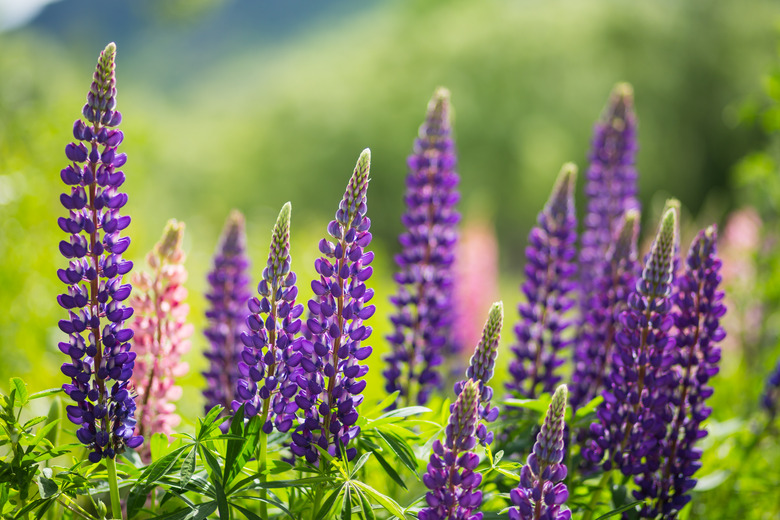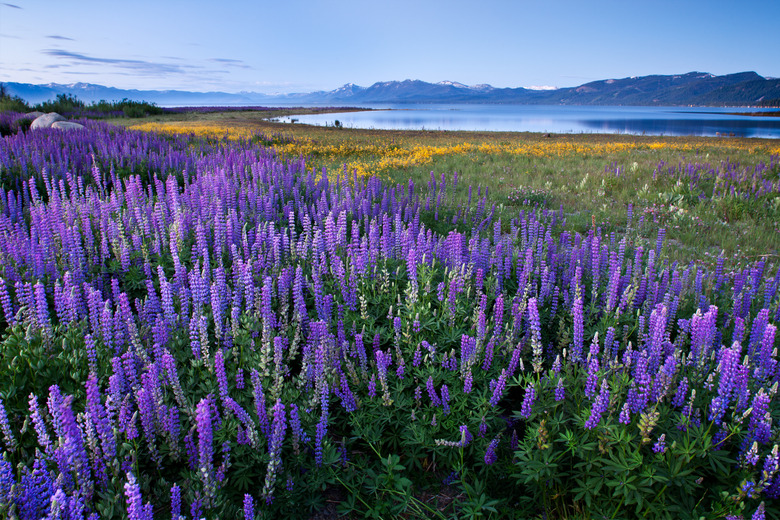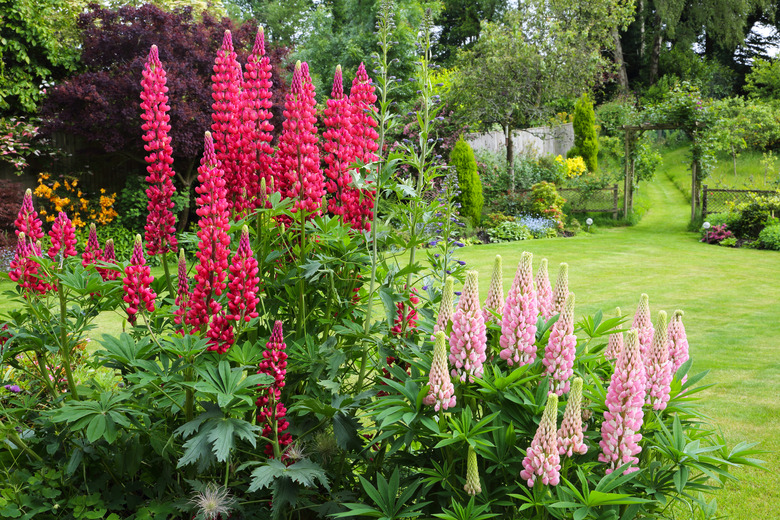How To Grow Lupines
We may receive a commission on purchases made from links.
The lupine (Lupinus spp., USDA plant hardiness zones 4-8) is a short-lived perennial with dramatic spikes of colorful flowers that bloom for a relatively long period, usually from May to July. Lupines like the cool soil found in regions with relatively mild summers, and well-drained soil is mandatory. This plant will thrive even in sandy soil, provided it is rich with organic material. In the right environment, lupines are very easy to grow, but they can be temperamental if conditions aren't exactly to their liking.
There are many, many native species of lupines that grow wild across North America, but most of these plants do not do particularly well in garden cultivation. The hybrids, however, especially cultivars derived from the Russell Hybrids group, are magnificent plants in the garden.
Best Uses for Lupines
Best Uses for Lupines
Hybrid lupines are most often used in mixed-border or perennial gardens, positioned in the middle or toward the rear of the bed where their tall, vertical spikes of flower racemes show to best advantage. The flowers are exceptionally vivid in shades of blue, purple, violet, yellow, pink, red, and white as well as bicolors. Lupines are also a favorite plant in cottage gardens and other classic-style garden designs. They are often seen in gardens with other heirloom flower species, such as delphiniums, hollyhocks, daisies, and irises.
Most lupines grow 3 to 4 feet tall, and while the palm-shaped, compound leaves are unusual and interesting, the foliage is not particularly dense. Lupines are therefore best surrounded by other plants that hide the sparseness of the lower foliage. There are also shorter hybrid cultivars that work well closer to the front of a mixed garden. Lupines look best when planted in clusters of several plants, but at the same time, they need enough space to ensure good air circulation, which prevents problems with fungal diseases.
Some gardeners follow a practice of sowing commercial lupine seeds along roadsides and in wild meadows, believing that they are assisting in the restoration of native wildflowers. However, the hybrid lupines most often planted in gardens are not native plants, and they may, in fact, crowd out the native species of lupines. As these hybrids go to seed, they often revert to their parent species, which can be alien and invasive in a new environment. Hybrid lupines should be kept in a cultivated garden where they can be supervised. If you wish to assist in wildflower restoration, make sure you are sowing seeds of lupine species that are truly native to your region.
How to Grow Lupines
How to Grow Lupines
Starting Lupines From Seed
Starting Lupines From Seed
Lupines are among the easiest of perennials to grow from seed. Some varieties may flower in their first year, but it's more common for the plants to grow and mature in their first year and then flower in subsequent years. Lupine seeds have a hard shell, and they will germinate better if you soak them between damp paper towels overnight before planting. Some gardeners "scarify" the seeds by rubbing them between pieces of sandpaper to soften the hard shell. Even then, don't be dismayed if it takes several weeks for your seeds to sprout, as lupine seeds can take up to 28 days to germinate.
Make sure to loosen the soil thoroughly before planting to a depth of at least 1 foot, as lupines have long taproots. If necessary, incorporate plenty of organic material to loosen the soil. Sow the seeds about 1/4 inch deep and keep the soil moist until they germinate and sprout. You can space the seeds 6 to 8 inches apart when planting, but eventually, they will need to be thinned to a spacing of 2 to 3 feet since they need plenty of air circulation.
If you are a native plant enthusiast and are interested in growing native lupines rather than cultivated hybrids, consider one of these species:
- Lupinus perennis subsp. perennis (northern sundial lupine, USDA zones 4-8): Native to the entire Eastern states and southern Canada, this species has fairly sparse flowers, but it is an important food for some rare butterflies, and the plant itself is considered endangered in some areas.
- Lupinus succulentus (USDA zones 7-10): Native to California, this species, often known as arroyo lupine, is one of the few pure species frequently grown as a garden plant. It grows 1 to 4 feet tall with the classic blue-purple flowers.
- Lupinus sulphureus subsp. kincaidii (Kincaid's lupine): Native to western Oregon and parts of southwestern Washington, Kincaid's lupine is a threatened species, and it is a critical food source for the endangered Fender's blue butterfly.
Starting Lupines From Seedlings
Starting Lupines From Seedlings
Hybrid lupines are often planted from nursery seedlings or from plants you start indoors from seeds. Plant the seedlings in well-loosened garden soil with a spacing of 2 to 3 feet at the same depth at which they were growing in the seedling pots. If you are growing plants from seeds that you start early indoors, they are best planted when they are 4 to 6 weeks old, which is before they have started developing their taproots.
In What Zone Do Lupines Grow Best?
In What Zone Do Lupines Grow Best?
Hybrid lupines can be grown in USDA zones 4 to 8, but they will do best in the northern part of that range where summers are relatively cool. In warmer regions, some afternoon shade may help to keep the soil cool and promote growth.
Regions experiencing climate warming are finding that lupines that once thrived are now becoming difficult to grow. An uncharacteristically warm, humid summer may find your lupines failing. Even in the best of circumstances, hybrid lupines are short-lived perennials, so be prepared to replant or propagate every few years.
When Should You Plant Lupines?
When Should You Plant Lupines?
Lupine seeds can be sown directly in the garden in the fall. The sprouted seedlings will overwinter and then reach blooming maturity the following spring. Alternatively, you can start them in the very early spring about four to six weeks before the last frost, but don't be surprised if they don't flower in their first year. Some gardeners in cold regions start seeds indoors as much as two months before planting; this may earn you flowers in the first year of growth.
Soil, Sunlight, and Water Recommendations for Lupines
Soil, Sunlight, and Water Recommendations for Lupines
Lupines generally grow best in full sun, but in warmer climates, lupines will appreciate some afternoon shade, which helps to keep the soil cool. Lupines prefer somewhat acidic soil. The ideal soil pH is 5.8 to 6.2. If the leaves begin to turn yellow with visible darker veins, this can be a sign that the soil is too alkaline, which prevents the plants from taking up the necessary nutrients from the soil.
Fertilizing with an acidifying fertilizer, such as that formulated for azaleas, will help correct this deficiency, and it may help the plants flower more robustly. Like many heavy-flowering plants, lupines need to be fertilized every month or so during the growing season. Well-fertilized plants usually return more vigorously the following year.
Lupines prefer soil that is kept evenly moist while they are growing, but once they are established with their long taproots, they really don't require watering unless conditions are very dry. Two weeks without watering is usually not a problem for well-established lupines. In fact, too much water is likely to lead to root rot.
How to Propagate Lupines
How to Propagate Lupines
Lupines do not react well to the dig-up-and-divide method that works for many perennials. They have a long taproot that does not like to be disturbed, so vegetative propagation should be limited to carefully pruning away small portions of the crown (basal cuttings) and replanting them. Plant the sections you remove in carefully prepared soil and keep them well-watered until new growth is evident.
Don't wait too long to take basal cuttings, as lupines usually have a life span of only four years or so. Take basal cuttings from healthy, full plants in year 2 or 3 of their life span. This is a good way to ensure that favorite hybrids continue in your garden.
Hybrid lupines do not come true from the seeds they produce. For example, while the Russell Hybrid cultivars do self-seed readily, the seeds will produce plants that revert to a parent species. The offspring are usually a pale blue without the bright colors found in the hybrids.
How to Winterize Lupines
How to Winterize Lupines
There is little winterizing necessary for lupines other than to cut off the foliage just above ground level. In very cold climates, a 2- to 3-inch layer of dry mulch (straw or dried leaves) can prevent winter kill, but make sure to remove this mulch very early in the spring, even before the last frost. Lupines don't like soggy, wet soil, which can cause rot.
Common Pests and Other Problems for Lupines
Common Pests and Other Problems for Lupines
There are a few common problems for lupines:
- Lupine aphids, a small, pale-green insect, may suck the sap out of lupines, which defoliates the plant and may seem to kill it. However, cutting off the plant at ground level may cause it to return with healthy new growth. A variety of insecticidal soaps or oils can kill aphids, and even hard blasts of water can dislodge them from the plant.
- Yellowing foliage is often a sign of chlorosis, which occurs when the soil pH is too high (alkaline). Fertilizing with an acidifying fertilizer or amending the soil with elemental sulfur will acidify the soil and improve the performance of lupines.
Common Diseases for Lupines
Common Diseases for Lupines
There are few truly serious diseases of lupines, but there are a few you may face:
- Powdery mildew is a common fungal disease of lupines. It covers the leaves with a whitish residue. It is most likely to occur in humid conditions where air circulation is poor. Mildew rarely kills the plants, but cutting back the foliage to ground level may allow the plant to rejuvenate with healthy foliage. Overhead watering can splash the mildew spores up onto the leaves, so ground-level watering may help prevent powdery mildew.
- Root rot may occur when lupines are grown in very wet, dense clayish soil. If this occurs, dig up the plants and amend the soil to improve drainage before trying to plant lupines again.


